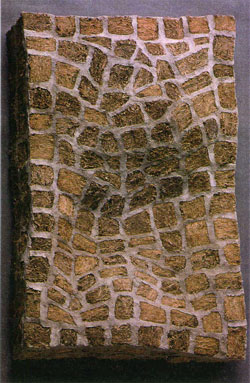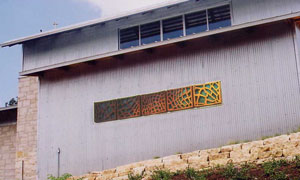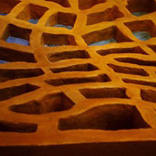Gilbert Vicario is assistant curator of Latin American Art at the Museum of Fine Arts, Houston. He was chosen to curate the United States entry in the 10th Cairo International Biennial based on his proposal to show a new piece by Los Angeles–based artist Daniel Joseph Martinez called The Fully Enlightened Earth Radiates Disaster Triumphant.
It is a life-sized animatronic — think the waxy and creepy plastic of the drunk Pirates of the Caribbean in the Disneyland ride.
This version, which bears the artist's likeness, forgoes the whimsy and
instead turns on itself, convulsing on the floor in something of a
short-circuit nightmare. Martinez describes it as capturing a moment
'where the body is taken over by something that causes it to catapult
itself into a genuinely radical space, outside of our norms and
comprehension.'[1] Given the subversive nature of the work, I thought
it would be interesting to get Gilbert's curatorial perspective on the
project and find out how he is thinking about the slippery shifts of
meaning that take place when a work collides with a very complex set of
cultural politics.
Michelle White: So,
first, congratulations on your selection as the curator of the Cairo
Biennial, which also means that you have been granted the very
glamorous title of 'United States Commissioner.' What exactly does that
mean? Do your responsibilities as a curator extend to cultural
diplomacy?
Gilbert Vicario: Thanks, Michelle. Well, I am
only the curator of the official US entry in the Cairo Biennial. The US
Commissioner in the framework of the traditional biennial model is the
person responsible for submitting an artist or artists for official
presentation in an international context. For the United States, this
is facilitated by the State Department and an advisory committee called
FACIE (Federal Advisory Committee on International Exhibitions), which selected my project.
I had originally submitted my project with Daniel Joseph Martinez for the São Paulo Biennial,
but they decided to do away with the traditional model and essentially
put together a team of curators from Brazil and Colombia. When we found
out that they would not accept my proposal, I was persuaded by the
State Department to resubmit the project for consideration in the Cairo
Biennial, which we got. The term 'cultural diplomacy' is inherent in my
capacity as commissioner, which is kind of funny but also scary, given
the context of where this biennial is held, which I now see as an
important gateway to the Middle East. We did translate the exhibition
catalogue into Egyptian Arabic. I believe we are the first American
team to actually do so, so I am very proud of that.
MW: It's so interesting, given the often
blatant political (and, after the Whitney Biennial in 1993, even
infamous) nature of Martinez's work, that the State Department would
actually encourage your proposal in a more contentious climate. Your
diplomatic role, therefore, is literally positioned between art and
politics, categories that usually are applied metaphorically in
discussions about art that is in service of social agendas. How does
this context change your curatorial decisions or even affect the
artist's work?
GV: I actually don't agree
that his work is 'overtly' political. It can be quite covert and very
intellectual most of the time. I agree, though, that given the
perception of his work after the 1993 Biennial — and after the incident
at Cornell in 1993, when the defacement of his work The Castle is Burning
in the university quad led to protests and a takeover of a campus
administrative building for three days by students demanding
recognition of the Latino community — the perception of Daniel Joseph
Martinez, the artist, has been pretty much defined. My decision to work
with Daniel wasn't predicated on his 'reputation' as a provocateur, but
rather on my interest in the way his work has shifted over the last
five years, and in particular in how he has begun to figuratively
insert himself into the work.
My diplomatic role thus far has been no different from what I am
accustomed to at the museum. Although you are right about my being
literally positioned between art and politics, it still remains
metaphoric on a certain level. Of course, there were guidelines about
presenting art in a Muslim country. This was important since neither
Daniel nor I had any experience in that respect. Originally, we had
submitted our proposal for São Paulo, so we hadn't considered issues
pertaining to censorship or cultural sensitivity. Our attitude was
simply: everyone hates Americans, so let's try really hard to not come
off as obnoxious, imperialistic, Western hegemonic pigs!
MW:
Can you tell me more about the project, such as the kinds of decisions
that you or the artist had to make as a result of these restrictions in
Cairo, as well as what you describe as the enormous weight of knowing
that you are representing a rather unpopular nation in what is
essentially a global forum.
GV: Well,
actually the project didn't change much once it was shifted from São
Paulo to Cairo, aside from the fact that the figure was originally
going to be nude. We had to abide by the State Department's
recommendations so as not to offend the Egyptians, so the figure is now
clothed in Banana Republic-like chinos and a white shirt. I think, in
the end, this slight adjustment didn't alter the original integrity of
the piece. It still functions as an open-ended commentary on Daniel's
exploration of technology and its relationship with the body. Of
course, the title of the piece, The Fully Enlightened Earth Radiates
Disaster Triumphant, adds an interesting subtext or metatext, given
one's understanding of the source of the title, which was taken from Adorno and Horkheimer's Dialectic of Enlightenment ,
written in 1947 after the defeat of the worker's movement. So once you
conflate the political subtext of the title with a life-sized
animatronics likeness of the artist flailing about on the floor of the
gallery, you can begin to imagine different possibilities of
interpretation.
Ultimately, though, both Daniel and I are
aware that the mere presence of Americans in an Islamic context will
engender criticism, outrage and revulsion. On a diplomatic level, the
US presence at the Cairo Biennial, and for that matter at the Dakar Biennial,
always engenders a certain amount of criticism leveled at the budgetary
discrepancy between the Americans and other poorer countries. Some have
suggested that maybe the US would do better to distribute monies
amongst those participants as a kind of goodwill gesture, although that
would obviously compromise the integrity of the American project.
MW: Right, so when you have this totally
crazy, hyperreal, life-sized body convulsing on the floor, rules of
decorum are, well, subjective, especially when the title is pulled from
the opening line of a treatise that is basically predicting disaster in
the wake of an enlightened mastery of knowledge. Given these questions
about economic, and by extension cultural, hegemony that international
art biennials bring up, do you think the very clear failure of a
high-tech, all-American, Disney animatronic, which is practically
destroying itself, might, in fact, be well-received as a literal
participant in this conversation?
GV: I'm
not sure the average Cairene will necessarily make the connection
between global economics, international art biennials and the ultimate
failure of information technology. In fact, chances are that the
reception of this project will best live on as a twice-removed,
disembodied remnant via its documentation or the response of those
connected to our 'art world' who happened to see the piece. I think the
popular reception of this piece will be no different from the reception
that Happiness is overrated got at the Museum of Fine Arts — one of
curiosity and shock.
MW: The piece you are referring to, TO MAKE A BLIND MAN MURDER FOR THE THINGS HE'S SEEN (happiness is overrated) (2002) , was shown as part of your exhibition Indelible Images (trafficking between life and death)
at the MFAH. It is also an animatronic in the likeness of the artist.
In this version the figure is hysterically cutting his wrists with
razor blades. Were you surprised at all by the response to this work?
GV:
Daniel gave me a copy of a video documentation of the piece beforehand,
as I actually had never seen the piece in person. I was a little
nervous after viewing the tape as I hadn't realized the full extent of
the 'performance.' So, basically I was expecting people to have a
strong reaction to the piece. Despite that, during the entire run of
the show, we only got one official complaint from somebody who felt the
museum was trivializing suicide by showing this piece. The Cairo piece,
I think, will be subtler and will not include references to suicide,
something that I was very conscious about, given the radical Islamic
context of suicide bombers. Also there is no audio component, just an
acoustic one, as the figure slams his hands and feet on the floor of
the gallery.
MW: For the MFAH you created an aseptic space
for the sculpture in the gallery, a white room with harsh fluorescent
lighting, and installed a ramp to let the viewer slowly approach. For
me, this really heightened the drama and the unexpectedness of such an
edgy performance. What kind of decisions about display are you
considering for Cairo?
GV: Actually, the room for Happiness is
part of the piece and was definitely meant to reference California
light and space art, Bruce Nauman, Michael Asher, the debate around the
white cube, etc., that emerged in the 1970s. The piece's presentation
in Cairo will basically function in a similar way. In fact, it will be
a complete counterpoint to the rest of the work in the biennial because
we insisted on being able to paint the gallery in super-white and to
add fluorescent lighting, whereas the rest of the biennial galleries
are painted a sandy beige color.
MW: So,
are you saying that this piece — which as a hyperrealist representation
formally tarnishes the pure space, in addition to bringing gruesome
behavior into a clean environment — is extending that discussion about
the white cube by putting it in dialogue with a particularly Western
idea about art?
GV: For Daniel, the work is
absolutely about contamination, and as I have argued in the past, much
of the sculpture produced in the early '90s functioned in a similar
manner. Think about Robert Gober or Doris Salcedo,
for example, and the ways that they played with phenomenological
perceptions. The work also, as you mention, is put into a fundamental
dialogue about the Western, and a modern, definition of art. Anytime
you place a work of art in a gallery, or the white cube, you are
complicitous with the Western tradition of exhibition display, and
hence with the function of the 'neutral' frame. So, extending this
dialogue from the '70s really serves as an interesting point of
discussion when it can happen in Egypt. And we don't even have to stop
there. The figure is also dressed in white, which creates an even more
complex dialogue around issues of 'whiteness,' whatever that means.
MW: So, it seems as if the biennial could
really enhance the reading of Martinez's work. As the curator, what is
the type of critical response you would most like to receive as a
result this project?
GV: I think my wish is
that Daniel's piece be well received, yet as the old paradox goes, 'If
a tree falls in the forest, and nobody is around to hear it, does it
make a sound?' That's my attitude right now about this biennial. In any
case, I haven't really thought much about critical feedback until quite
recently. This work has definitely pushed the artist in a new and
unexpected direction, and it is important for me that he get
acknowledgment for that. As for a critical response within the context
of the biennial, as an American project within a predominantly Middle
Eastern venue, I have no idea. There are few critics in Egypt and
regrettably most can never get past the usual anti-American or
anti-Western European position, despite the fact that contemporary art
in the Middle East is inextricably tied to the West.
MW: Thanks for the conversation. I look forward to finding out what happens.
GV: And I will send you pictures of the installation from Cairo as soon as the show goes up in the next few weeks.
Michelle White is a curatorial assistant at The Menil Collection in
Houston. She is a frequent contributor to Glasstire, Art Papers and
Artlies.









